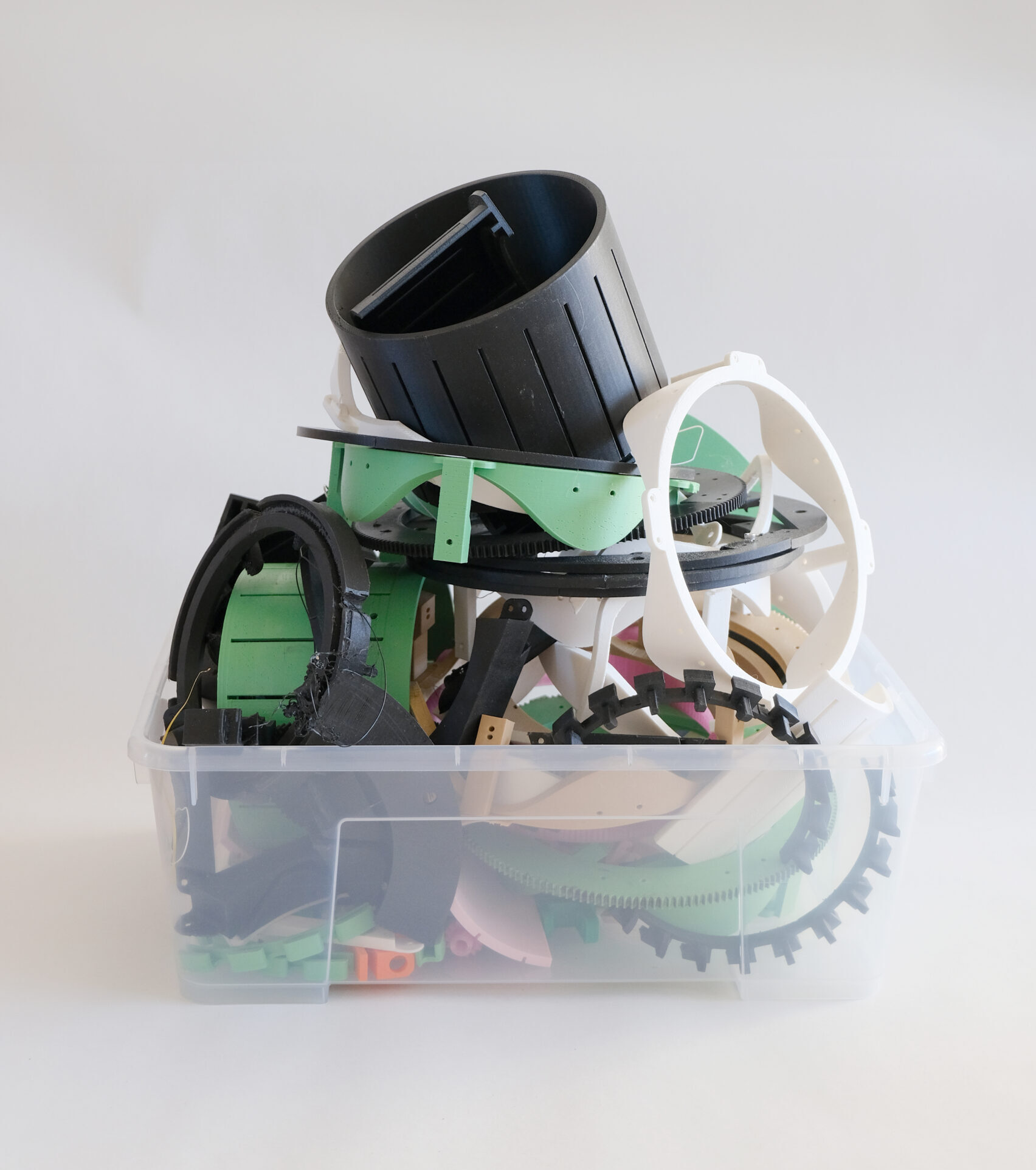The PLA Paradox: Can 3D printing become a circular practice?
- My 3D Printer: BambuLab P1S
- Recycled PLA I like: Reflow Filament
- Sustainable 3D Printing Guide


As a textile and material designer, I’ve always believed that innovation should go hand-in-hand with sustainability. During my Master’s project in 2023/24, I developed an open-source machine that is composed mostly of 3D printed parts that I modelled and printed myself. This experience deeply shaped my approach to design, encouraging me to work in ways that prioritize circular systems and reduce waste. Now, I’m bringing that same mindset into my day-to-day 3D printing practice. So far I have printed with common filaments as PLA, PETG, and TPU, and only last year I started to experiment with recycled filaments, especially recycled PLA. Let me share some thoughts with you.
The Sustainability Paradox of PLA
PLA (Polylactic Acid), probably the most famous filament for 3D printing, is often marketed as a sustainable material, because it’s derived from renewable resources like corn starch and seems to have better biodegradability than common plastics like polyesther. However, it is still a type of plastic. When I first started using PLA, I was indeed drawn to its promise of being a sustainable material for 3D printing. But through my research and experience, I quickly realized that the reality is more complex:
↪ PLA doesn’t biodegrade just like that: Unless PLA is composted under specific industrial conditions, it can linger in landfills for years. It won’t break down naturally in your home compost bin or in the environment, like we’re often led to believe. PLA is often marketed as biobased and biodegradable, but in reality, “polylactic acid is a compostable polymer that can only degrade under controlled conditions.” It requires temperatures between 55–175°C to break down, far beyond what is achievable in most natural environments. Ali et al. researched the marine degradation of Polylactic Acid, since human plastic waste ends up in the oceans as well. And it is not very cutesy, not very demure of PLA what the researchers found out:
“Polylactic acid is one of the most widely used biopolymers, accounting for 33% of all bioplastics produced in 2021. Although biodegradable in vivo, polylactic acid is not completely degradable under natural environmental conditions, notably under aquatic conditions. Polylactic acid disintegrates into microplastics faster than petroleum-based plastics and may pose severe threats to the exposed biota.” (Ali et al., 2022)
↪ 3D printing generates significant waste: One major issue with digital fabrication, being all cool and that, is the amount of waste it creates. Failed prints, support structures, and unwanted prototypes make up a large part of this waste, especially when working with multicolored prints— which my BambuLab P1S allows me to do. I tried the multicolor print only one time, and I was shocked with the filament going to waste! Makers have a good sense of humor though, calling the “filament poop”. Stefan from CNC Kitchen calculated for one of his multicolored prints 2,5 times more waste. This makes me think back to my own projects where I often found myself generating more material waste than I had anticipated.
What is the solution to all this 3D printed waste?

While we can be more mindful during the digital modeling process to avoid repeated and only slightly altered prints, some waste will stay unavoidable. The good news is, there are already companies, studios, and organizations offering recycling programs or working on plastic recycling projects. The possibilities range from turning plastic waste, failed prints, and leftover filaments into new filament rolls or even recycled plastic products. Here in Germany, companies like RecyclingFabrik or Redline Filament take your 3d printed waste and turn it into recycled material, and on a more global level: Precious Plastic are really paving the way in offering a local plastic recycling option in lots of places of the world.
Some 3D printers and robotic arms (for non-planar 3D printing) are even capable of using shredded plastic waste with attached pellet extruders. If you want to know more about this you should grab a coffee with Antonia Dönitz, who knows everything and more about pellet extrusion for 3D printing. I came across The Trash Printer, an open-source large-format 3D printer that uses shredded plastic in the printing process – two steps in one machine! The Artme3D Filament Extruder is not connected to a 3D printer, but nevertheless a very cool machine to make one’s own filament and a machine I would love to own some day. In case of the Artme3D, the missing accessible piece is an affordable desktop shredder for failed prints and filament waste. But maybe this Micro Plastic Shredder might just be the right thing?
For my recent projects, I’ve experimented with different types from the company Reflow Filament, who produce beautiful, filament made from plastic waste, e.g. food waste or PET-bottles. The printing quality is really good and I really like the colours – I wish they would recycle PLA filament! What is on the top of my to-do-list right now, is to send all the accumulated PLA waste to a company in Germany to recycle it and I hope I will get back a recycled filament roll and not only a voucher to buy from them. Anyhow, I think me and my wife will invest or build our own filament extruder in the near future 🙂 Stay tuned for more!
Links and References:
1) https://www.linkedin.com/pulse/3d-printing-waste-problem-causes-solutions-ravi-toor-cbgee/(Accessed on: 25.05.2024)
2) https://www.linkedin.com/posts/ravitoor_3dprinting-sustainability-circulareconomy-activity-7139931854018613249-qJ9L/?utm_source=share&utm_medium=member_desktop (Accessed on: 25.05.2024)
3) Ali, W., Ali, H., & Gillani, S. et al. (2023). Polylactic acid synthesis, biodegradability, conversion to microplastics and toxicity: a review. Environmental Chemistry Letters, 21, 1761–1786. https://doi.org/10.1007/s10311-023-01564-8 (Accessed 02.06.2024).
4) https://recyclingfabrik.com/ (Accessed on: 30.05.2024)
5) https://www.redline-filament.com/pages/recycling-programm (Accessed on: 30.05.2024)
6) https://www.preciousplastic.com/ (Accessed on: 30.05.2024)